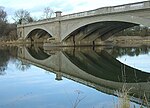Gunthorpe, Nottinghamshire
Newark and SherwoodUse British English from May 2016Villages in Nottinghamshire

Gunthorpe is a village and civil parish in Nottinghamshire, England. Its population of 752 at the 2011 census was estimated at 559 in 2019. It lies on the left bank of the River Trent. Gunthorpe's on the A6097 is the only road bridge over the river between Newark and Nottingham.
Excerpt from the Wikipedia article Gunthorpe, Nottinghamshire (License: CC BY-SA 3.0, Authors, Images).Gunthorpe, Nottinghamshire
Main Street, Newark and Sherwood Gunthorpe
Geographical coordinates (GPS) Address Nearby Places Show on map
Geographical coordinates (GPS)
| Latitude | Longitude |
|---|---|
| N 52.99 ° | E -0.987 ° |
Address
Davids Lane
Main Street
NG14 7ES Newark and Sherwood, Gunthorpe
England, United Kingdom
Open on Google Maps







